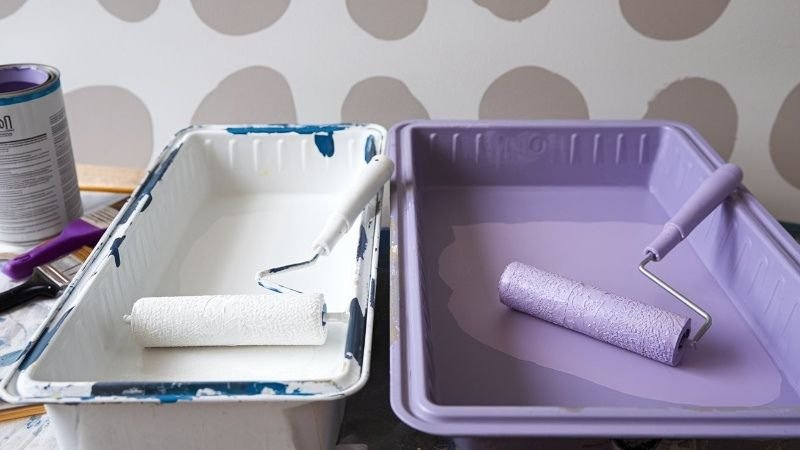Essential Tools Needed for a Perfect Paint Job
Painting is an art that needs technique to be done with perfection. To get a professional finish on your surface, you must be completely aware of the science of colors and essential tools per the requirements. Whether you are painting a grey structure, an already treated surface, or your furniture, you need different tools to get a satisfactory result and a desired finish. Before digging deeper into the artistic performance of the tools to make your experience extraordinarily heartwarming, let’s learn about all the essential tools used in the painting work.
1- Scrapers and Putty Knives
Scrappers and knives are used to remove old paint, smooth rough surfaces, and fill cracks and holes. A paint scraper is a useful tool for removing old paint, cleaning surfaces, and smoothing rough spots. Putty knives are used for filling in cracks and holes with spackle or joint compound before painting.
2- Sandpaper and Sanding Blocks

Sandpapers are used to smooth the surface before painting. There are two types: coarse grits and finer grits. Coarse grits (60-80) are used for heavy sanding, while finer grits (120-220) offer smooth surfaces before painting. Sand blocks are easier to use than sandpapers and provide a more even sanding surface.
Also Read: 5 DIY Paint Work Techniques You Must Try
3- Paint Brushes
Paint brushes do magic if chosen right for the compatible surface. Various sizes and designs of paint brushes are used for different surfaces and to achieve versatile patterns. Some of these are angled detail and flat brushes. Angled Brush is ideally utilized to paint the edges and corners of the room. These bristles help avoid rough patches and create precise lines. Flat Brush paints the central or broad areas left after cutting in with the angled brushes. Flat brushes are an ideal choice for walls and ceilings of a room. Meanwhile, detail brushes cover intricate and small areas, such as lines around a switchboard on the wall. These brushes provide a steady hand for narrow spaces.
4- Material Matters
Material matters are used for paint mixing. These are added with different kinds of paint to achieve a particular finish on the surface. Synthetic and natural are prominently used for this purpose. Synthetic bristles go well with water-based paints and render a smooth finish. Natural bristles are best for oil-based paints and varnishes. These bristles can absorb a substantial amount of paint that helps achieve other finishes on the broad surfaces.
5- Rollers
Rollers are used to paint broad surfaces with ease in no time. One can achieve the desired finish and pattern by choosing the right roller. Rollers, such as short and long nap rollers, are available in different sizes and materials. The length of the nap of a roller determines the texture of the paint finish on the surface. Short naps are usually of 1/4 to 3/8 inches. This length suits smooth surfaces, whereas longer naps come with a 1/2 to 1-inch length that works well on rough surfaces. Besides that, different roller materials are used to achieve other ends, such as polyester or nylon rollers, which are solid and easy to maintain.
In contrast, lamb’s wool rollers hold a lot of paint and are ideal for larger projects. Standard-sized roller frames are pretty convenient and can be adjusted to most roller covers. On the other hand, extendable frames are a perfect option for high walls and ceilings.
6- Paint Trays and Liners

Paint trays are used to load paint on the rollers conveniently. There are two types of trays: standard trays and liners. Standard trays can hold the paint and allow only the right quantity of paint to be applied to the roller. They also remove excess paint off the roller when the roller is rubbed to its surface. Tray liners are disposable liners that can save cleanup time and keep your tray in good condition for a long time.
7- Painter’s Tape
Two types of tape are usually used to accomplish your paint project neatly: masking tape and edge lock tape. Masking tape is used to protect surfaces that you do not want to paint. To avoid your paint from bleeding underneath, ensure the safe application of this tape. Edge lock tape offers extra protection against paint spilling to create precise and clean edges.
8- Paint Edgers
A paint edger is a tool for clean and precise paintwork around edges without using tapes. It ensures speed and paint perfection in creating accurate lines.
9- Plastic Sheets and Drop Clothes:
Plastic sheets and drop cloths are used to protect surrounding surfaces such as furniture, floors, and other items. They are reusable and easy to clean.
10- Ladder
A ladder is an essential tool to ensure trouble-free paintwork. It is used to paint on high surfaces. Besides ladders, step tools are also perfect for comparatively lower heights.
11- Safety Gear
Paints contain harmful chemicals and sometimes contain significant concentrations of volatile organic substances that can be dangerous to health. To ensure your safety, wear masks, gloves, and protective eyewear to protect yourself from harmful fumes and dust, skin irritation, and spills and splashes of paint and dust.
Conclusion
Invest in the proper, high-quality tools to achieve professional perfection in your painting project. From preparing your wall’s surface to finishing the entire project, painting tools significantly elevate the whole painting experience. Preparation tools provide the perfect surface to start your paintwork with. Painting tools ensure timeless work and smooth finishes. Moreover, safety gear ensures health and safety from harmful chemicals.
FAQs
Q1- What tools are required for the paintwork?
Ans: For quality paint work to be completed quickly, many tools, such as scrappers, brushes, putty knives, rollers, respirators, ladders, paint trays, and taps, are required.
Q2- What sand papers or grits are used for heavy sanding?
Ans: Coarse grits (60-80) are recommended for heavy sanding in paintwork. These types of sandpapers easily handle heavy wall preparation.
Q3- What determines the texture of the paint finish on the wall?
Ans: Maintaining the length of the nap of the roller tool used in the paintwork can enhance the texture of the paint finish.





Leave a Reply